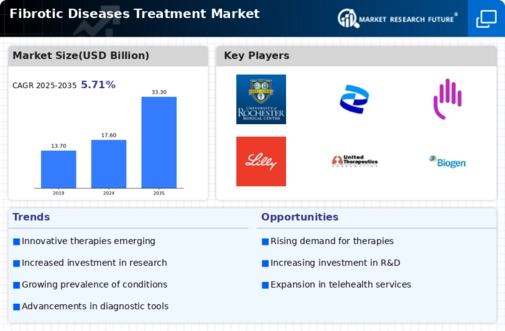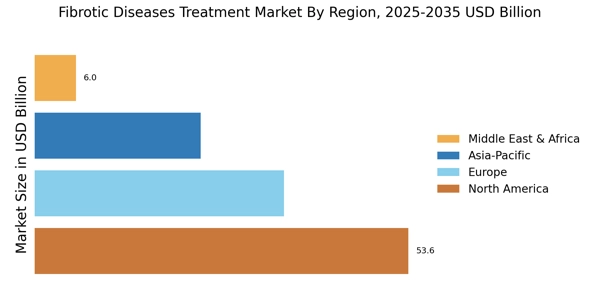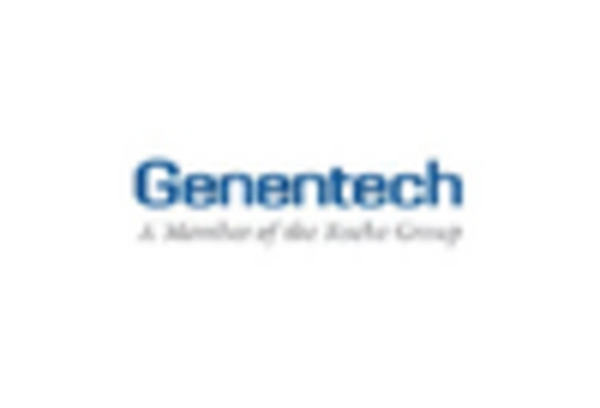Rising Prevalence of Fibrotic Diseases
The increasing incidence of fibrotic diseases, such as idiopathic pulmonary fibrosis and systemic sclerosis, is a primary driver of the Fibrotic Diseases Treatment Market. Recent estimates suggest that the prevalence of idiopathic pulmonary fibrosis may reach approximately 200,000 cases annually in certain regions. This rising prevalence necessitates the development of effective treatment options, thereby propelling market growth. As healthcare systems strive to address this growing burden, investments in research and innovative therapies are likely to increase. Furthermore, the aging population, which is more susceptible to fibrotic diseases, contributes to the expanding patient pool. Consequently, the Fibrotic Diseases Treatment Market is poised for significant expansion as stakeholders seek to meet the demands of this increasing patient demographic.
Advancements in Diagnostic Technologies
Technological advancements in diagnostic tools are transforming the Fibrotic Diseases Treatment Market. Enhanced imaging techniques, such as high-resolution computed tomography (HRCT), allow for earlier and more accurate detection of fibrotic diseases. This early diagnosis is crucial, as it enables timely intervention and treatment, potentially improving patient outcomes. Moreover, the integration of biomarkers in diagnostics is gaining traction, facilitating personalized treatment approaches. As diagnostic capabilities improve, healthcare providers are better equipped to identify and manage fibrotic diseases, which may lead to an increase in treatment uptake. The growing emphasis on precision medicine further underscores the importance of these advancements, as they align with the evolving landscape of the Fibrotic Diseases Treatment Market.
Growing Awareness and Education Initiatives
Raising awareness about fibrotic diseases is becoming increasingly important, driving growth in the Fibrotic Diseases Treatment Market. Educational initiatives aimed at both healthcare professionals and the general public are essential for improving understanding of these conditions. Increased awareness can lead to earlier diagnosis and treatment, ultimately enhancing patient outcomes. Organizations dedicated to fibrotic diseases are actively promoting educational campaigns, which may contribute to a more informed patient population. Furthermore, as healthcare providers become more knowledgeable about the complexities of fibrotic diseases, they are more likely to pursue appropriate treatment options. This heightened awareness is expected to stimulate demand within the Fibrotic Diseases Treatment Market, as patients seek effective therapies and healthcare systems adapt to meet these needs.
Regulatory Support for Innovative Therapies
Regulatory bodies are increasingly supportive of innovative therapies for fibrotic diseases, which is a key driver of the Fibrotic Diseases Treatment Market. Initiatives aimed at expediting the approval process for new treatments, such as breakthrough therapy designations, are encouraging pharmaceutical companies to invest in research and development. This regulatory environment fosters innovation and may lead to the introduction of novel therapies that address the complexities of fibrotic diseases. As a result, the market is likely to witness a wave of new products entering the pipeline, enhancing treatment options for patients. The proactive stance of regulatory agencies not only accelerates the availability of new therapies but also instills confidence in stakeholders, further propelling the Fibrotic Diseases Treatment Market.
Increased Investment in Research and Development
The Fibrotic Diseases Treatment Market is experiencing a surge in investment directed towards research and development. Pharmaceutical companies and biotechnology firms are increasingly allocating resources to discover novel therapeutics aimed at treating fibrotic diseases. This trend is evidenced by the growing number of clinical trials focused on innovative treatment modalities, including antifibrotic agents and immunotherapies. In recent years, the market has seen a notable increase in funding, with estimates indicating that R&D expenditures in this sector could exceed several billion dollars annually. Such investments are essential for advancing the understanding of fibrotic disease mechanisms and developing effective therapies. As a result, the Fibrotic Diseases Treatment Market is likely to benefit from a pipeline of new treatments that could address unmet medical needs.


















Leave a Comment